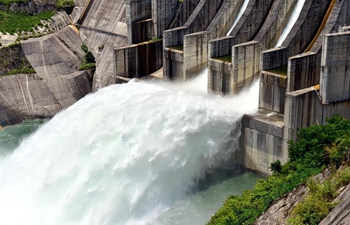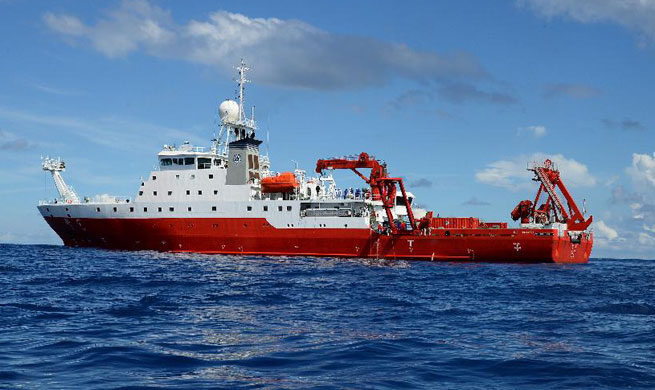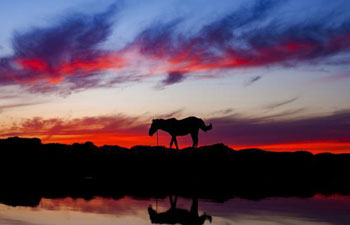by Peter Mertz
DENVER, July 25 (Xinhua) -- Farmers and scientists in North Dakota, Montana, and South Dakota are praying for rain and preparing for a drought that could cripple the region for decades.
"It's been a brutal summer," Montana State University (MSU) scientist Darrin Boss told Xinhua Tuesday, who saw no end in sight to the conditions.Boss is one of 21 scientists at MSU's esteemed 7,000-acre (28.3 square km) Agriculture Research Center near Bozeman, Montana.
"It's a crisis ... way more than people think," Mark Watne, president of the North Dakota Farmers Union, said Monday.
"I've driven through areas where you would expect to see a spindly wheat stand, but there's no crop left -- it's gone," Watne said.
North Dakota, South Dakota and Montana are all experiencing debilitating 2017 droughts that are forcing farmers and politicians to clamor for federal relief.
The three large western states near the Canadian border possess in total 763,678 square km of mostly flat farmland, and are three of the top four wheat-producing states in the country, according to Statista, one of the world's leading online statistics databases.
But both Dakotas saw big drops from 2015 to 2016 in crop production due to the onset of drought conditions, and 2017 looks to be even worse. U.S. Drought Monitor data released last week showed 50 percent of North Dakota in extreme or severe drought, 30 percent of South Dakota, and 20 percent of Montana.
Drought Monitor officials said this was not abnormal, but perhaps the beginning of a long, historic trend.
In fact, 11 of the past 14 years have seen drought in much of the American West, from California across to Texas and Oklahoma, according to the Monitor.
Last month Montana Governor Steve Bullock asked U.S. Agriculture Secretary Sonny Perdue for a drought disaster designation that may be declared soon for the three-state region.
Montana, the country's fourth-largest state, has 28,000 farms and ranches spread across 59.7 million acres (241,500 square km) and produces a wide range of commodities including wheat, dry peas, lentils, flax, honey, and beef -- a 5-billion-U.S.-dollar industry.
Bullock declared a drought emergency in 19 counties in north central and eastern Montana, and two American Indian reservations.
At the same time, neighboring North Dakota Governor Doug Burgum declared a drought emergency.
The impact of the drought will likely be felt not just by farmers but also consumers, state Agriculture Commissioner Doug Goehring said.
Agriculture in North Dakota is an 11-billion-dollar a year industry, and the state leads the nation in the production of nearly a dozen crops.
"It's going to affect bread (prices) at the grocery store," Goehring said, adding that the costs of dry beans and vegetable oil were also expected to rise.
In South Dakota, the Drought Monitor showed 82 percent of the state in some stage of drought, up from 72 percent in the previous week.
The U.S. Agriculture Department said topsoil moisture is 82 percent short and subsoil moisture is 81 percent short, projecting possible Dust Bowl conditions should the drought continue.
The severe conditions in America's West had historians and farmers remembering the drought and "Dust Bowl" of the 1930s, considered the worst agricultural disaster in American history.
"Those were desperate times in American history," recalled retired Denver history professor John Yee.
"People were hungry and homeless, and the drought hit in four waves over seven years. It looked somewhat like what's going on today -- 80 years later."
Between 1934-1940, droughts ravaged 400,000 square kilometers in parts of Texas, Oklahoma, New Mexico, Colorado and Kansas, that left tens of thousands homeless and added to the misery of the Great Depression (1929-1941).
What's more, recent scientific data suggest the current drought may be here to stay.
A stunning 2015 NASA prediction showed that the chances of a 35-year "megadrought" striking the southwest and central Great Plains by 2100 are above 80 percent if the world stays on its current trajectory of greenhouse gas emissions.
"Even at the middle-of-the-road scenario, we see enough warming and drying to push us past the worst droughts experienced in the region since the medieval era," said Benjamin Cook, the study's lead author and NASA scientist.
"We see some of those impacts going on now in California," said Cook, referring to the ongoing drought that is the worst in state history.
Up until last week, Wes Niederman's Morristown, North Dakota ranch had received only 1.2 inches (3.04 cm) of rain since April.
"Generally, we get about 2,000 bales, but we got 477 out of what we cut," Niederman said, whose overall output is down by 25 percent.
"Some spots have gotten about an inch of rain this week," he said. "So it's encouraging, but it's not going to solve things."

















